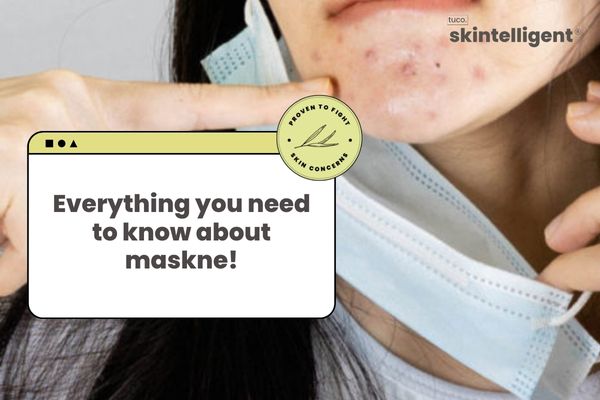
How to prevent Maskne
Share
Maskne, or acne with a mask, is not only a slang phrase; it's also a pretty typical side effect of wearing a face mask. In this pandemic-ravaged society, a mask has evolved from a simple accessory to your main line of defence against the deadly COVID-19. But everyday use of a mask for long periods of time has drawbacks as well. Maskne pimples, or acne brought on by masks, is one of the most prevalent side effects. Maskne is a side effect of mask use and includes skin irritation, redness, bumpiness, pimples, and more serious conditions including folliculitis and dermatitis.
Common Skin problems under Maskne
Acne: When your pores are blocked with debris, oil, and dead skin cells, acne develops. It may result in blackheads, whiteheads, or pimples. It can impact anyone, but it is more likely to do so if you have a history of acne. It appears to be especially prevalent among those who use surgical masks and certain types of respirators.
Rosacea: Wearing a mask when suffering from rosacea may trigger flare-ups. Maskne Pimples and redness may result from this.
Inflammatory contact dermatitis: When you have an allergy or sensitivity to the material of your mask, contact dermatitis might result. It could cause a red rash, discomfort, and blisters. The cheekbones and the bridge of the nose are frequently affected by this most prevalent kind of mask response. More susceptible individuals are those who wear a mask continuously for 6 hours or longer and those with damaged skin barriers. Skin ulceration and dry, scaly areas are only a few symptoms.
Atopic dermatitis: Because of the irritating impact of wearing a mask, skin symptoms, also known as atopic dermatitis, might occur or worsen in those whose skin is sensitive due to eczema results maskne.
Periorificial dermatitis: In this disease, little pimples form around the lips and eyes. It may occur when wearing a mask, after applying makeup or corticosteroid treatments, or seemingly out of the blue.
Folliculitis: An infection of your hair follicles called foliculitis results in pimples that resemble an acne outbreak. You could also feel itchy or uncomfortable.
Urticaria: Some types of masks' downward pressure or exposure to allergens like latex in people who are vulnerable might cause hives or blisters. Urticaria due to pressure might arise immediately or within 24 hours. dependable source Normally, allergic urticaria develops immediately and goes away 24 hours after the trigger is removed.
Seborrhoeic eczema. In this type of dermatitis, greasy yellow scales develop, mainly on the maskne on chin, forehead, eyebrows, and in folds maskne around the mouth, maskne on nose and lips.
Causes of Maskne
The precise reason of your symptoms may differ since maskne can entail a variety of skin disorders. Maskne is typically the consequence of blocked pores. On your skin, there are already dead skin cells, germs, and oil. However, these compounds might accumulate more and clog your pores while you're wearing a mask.
A mask also collects moisture from your respiration and perspiration, which might make acne more likely. Friction is another conceivable factor. Your skin may chafe and get irritated if a face covering rubs against it. Alternatively, you can be allergic or sensitive to the material used for your face mask. Some masks include a chemical pretreatment or have a harsh sensation to the skin.
How to treat maskne
If you are seeking the best way to treat maskne then we have researched and found some maskne remedy just for you!
- Cleanse and moisturize your face daily with a non-comedogenic product.
- Protect your lips by applying petroleum jelly.
- Skip the makeup when wearing a mask.
- Avoid trying new cosmetic products that can irritate your skin.
- If you wear a cloth mask, wash them after a couple of wears to avoid any skin concerns from forming.
Recommended Product tuco skintelligent products to fight maskne
Check out our best skincare for maskne
- Calendula oil in this soap has antifungal and anti-inflammatory properties for soothing eczema which best way to treat maskne
- Castor oil in this facewash, fights acne and is a natural cleanser
- Almond oil is rich in fatty acids and is a proven acne combatant, in this acne clearing body wash.
Acne clearing body lotion
- Shea and cocoa butter are effective moisturizers that soften skin
- Chamomile used in this serum acts as a powerful antioxidant to eliminate free radicals
How to Prevent Maskne
-
Replace and clean your mask.
Make sure the mask you're applying is clean if you want to prevent your skin from unwelcome outbreaks. If you use disposable masks, you may prevent dirt and oils from accumulating on your face by changing them frequently during the day.
If your masks are disposable, make sure you're replacing them at least everyday. Oils from your skin can accumulate on paper or cloth, block pores, and cause outbreaks.
If the mask you want is made of fabric, wash them daily to avoid cross contamination.
-
Products and best maske treatments
You may use treatments and skincare items to assist remove acne when it appears. When it comes to maskne, this is the same. Use products containing salicylic acid or benzoyl peroxide. These active chemicals can be found in washes or spot treatments, depending on the product. Before applying the product to your face if you're a first-time user, try it on a small patch of skin on the inside of your forearm to see whether your skin can withstand it.
-
Consistently rinse your skin
For clear, healthy skin, wash your face with a mild cleanser first thing in the morning and directly before night. Always use a non-comedogenic cleanser so as to not clog your pores.
-
Do not pick on your skin
Do your best not to touch your face or pick at your mask. This could be the trickiest advice to follow because it's so tempting to touch your face or pick at pimples. However, touching your face can transfer oils from your hands to your face, which can clog pores and cause acne. Additionally, picking at your acne can worsen its look over time. Therefore, a hands-off approach is better for your skin even if it could be difficult to resist the impulse to touch and pick.
-
Lessen the resistance
Try to adopt strategies that lessen friction between the mask and your skin if you're chafing or feeling uncomfortable when wearing a mask.
The mask straps may be loosened, padding can be placed beneath the straps behind the ears, or a headband-style mask can be used. Use of a bigger mask or a mask with a different design is another option.
6.How to prevent maskne for nurses?
Some nurses and carers have reported severe skin damage after wearing face masks for prolonged periods. PHE recommends wearing PPE in only two-hour stretches, if possible. This gives the skin a chance to recover and dry in between use. Using a simple moisturiser 30 minutes before PPE is donned will keep the skin hydrated.
-
How to prevent maskne while working out?
Silk is a cooler alternative than cotton or polyester for really hot workouts. This version is washable, has a N95 filter to help prevent particle dispersal in the air, and is coated with a coating that helps limit germ survival on the fabric's surface.
FAQs
- Which kind of mask is the best way to prevent maskne?
Masks made of breathable fabric like cotton are safest to prevent maskne. The mask should be made of soft, breathable fabric, and should ideally have at least two layers of fabric. Make sure that you keep your masks clean by washing them after every use.
- Are disposable masks better for avoiding maskne?
A: If you have dry skin, then disposable masks are a better option for you. If you have oily or acne-prone skin, cotton cloth masks will help you in to prevent maskne.
- How can you stop maskne from occurring?
A: Maskne pimple can be avoided by giving your skin a break of 15 mins every 4 hours of wearing a mask. However, make sure that you maintain physical distancing during those mask-free 15 minutes. You should also keep your face clean, moisturized and hydrated at all times underneath the
mask.

